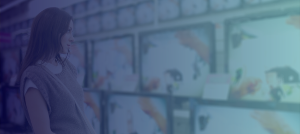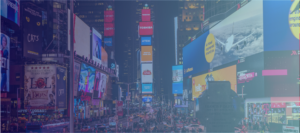THE DIFFERENCE BETWEEN DIGITAL AND SMART SIGNAGE
At TAKTIK we are taking a step away from digital signage. We want to say goodbye to the static marketing and communication that has been so dominant over the last few decades. It is time for a more human, but data driven, approach: smart signage.
Digital Signage
Digital signage has been a staple for many industries to communicate on location with their audience. It was a natural progression that followed the technological advancements in screens and software. No longer did marketing or communication departments have to wait for the printers to finish their banners and advertisements, nor did they have to reserve large budgets to produce them.
Digital signage always had a strong focus on hardware. With the rapid developments in screen resolution and dimensions, content had to take a backseat. Not that there was no budget to create quality content. Companies were just continuing their communication in the same ways they have always done. There was very little effort put in developing platform specific marketing techniques or strategy optimisation.
As screens were getting thinner, there was a movement that was growing parallel to that of digital signage: social media marketing. As users could not change anything about the platform, the focus has always been on content and adjusting the same content to the guidelines of all the different platforms.
Social media influencers adjust their content to the different limitations of each platform and react instantly to newly added features. When Instagram added their 15 second video feature for iOS devices, it instantly created a new style of video creation that fully utilised the opportunities this format offered. Those who got it right from the start were directly catapulted into stardom.
This field is far more reactionary than digital signage ever was.
Digital signage instead focused on offering more visually pleasing content formats. Video went from SD to HD, 4K, and HDR. However, the content it was showing looked better, but was not optimised for the communication channel.
That is why we think it is time to switch to smart signage: it is time to modernise.
Smart signage
Smart signage continues where digital signage left off. It uses the same hardware, but uses it in a fundamentally different way. It uses the broadcasted content to create connections with its audience members that turn into relationships.
Here hardware becomes a mean again, not a goal on its own. The focus is on how the content can be best presented using the hardware and location. They work together to create the optimal situation to interact with their audience on the specific location that screen is mounted.
The goal is that the content is seen, understood, and acted upon. Smart signage is in a unique position here: it needs to fight less over the audience’s attention. Online marketing needs to compete with hundreds of other messages, whereas smart signage is often done at places where people are already looking for information to guide them.
Another lesson mart signage uses from digital marketing is that it experiments to find out which content works best. By testing different messages and visuals, companies can optimise their smart signage campaign.
Content experiments should be quick and cheap. This allows companies to isolate certain variables, but also to take risks, so they can be certain of what works best and what does not.
At TAKTIK we are taking a step away from digital signage. It is time for a more human, but data driven, approach: smart signage. http://bit.ly/2AtJboA
Posted by TAKTIK on Wednesday, 8 November 2017
Content as a Service
We often think of advertising or corporate communication as something inherently intrusive, but consumers are actually looking for ways to connect with them. Both online and offline. However, it requires a different approach to content and communication to turn intrusive advertising into welcome messaging.
Intrusive advertising often consists of a corporate message, which tells the audience members what they should do: buy this, try that, etc. Online these messages are already on their way out. Here advertising focuses on how a certain product or service helps their customers achieve a certain goal.
Smart signage uses the same approach as online marketing, but adjusts it to fit its own medium. When audiences interact with screens on location they are likely there for a specific reason.
For example customers in a clothing store are there to buy, hotel guests in the corridor to the breakfast room are there to eat, and fans in a stadium are there to support their favourite team or athlete.
There is a specific reason and need for these people. Smart signage addresses this by offering the right information and content for that particular moment and place.
In the case of a customer in a clothing store this can turn into direct conversion: the shopper buys an advertised item. But more importantly it can strike a chord with them, which then turns into brand loyalty or makes them a brand advocate.
Just have a look on LinkedIn to see how much impact small acts of kindness have on consumers. For over a year most of the viral posts consisted of managers sharing thoughtful acts from the customer success teams. Even leaving a simple handwritten note in a guest’s hotel room was enough to get thousands of likes.
In all of these cases, the content that was offered provided a service: either it gave the right information at the right time or it added to the service the customer bought. Content becomes its own product or service.
Why you should care
Consumer behaviour and communication guidelines have changed rapidly over the last decade. It is not just the millennial audience that continues to reinvent itself. Digitalisation has also changed the way the baby boomers look at communication and the relation they have with companies.
There has been a massive switch in how companies interact with customers. Expectations in terms of personalisation, ease, and availability have skyrocketed thanks to improvements in UI and UX online. The online world has already had an irreversible influence on our offline lives.
Smart signage is all about translating the lessons learned from this decade of disruption to communicating with visitors in real life.
Making the transition to smart signage
Digital signage is on its way out. The way it communicates with its audience is outdated and ineffective. Smart signage marks the start for a new type of communication for companies and institutions.
It is time to connect with audience members and build up a relation instead of creating intrusive advertisements to fight for the attention of new customers. This goes just as well for the private as the public sector. People expect the personalisation and ease they are used to online in the real world as well.
Understanding the user and growing with them is what made all of the current tech giants so big. Google knows what you are looking for, Facebook knows what you want to see, and Uber knows where you plan to go.
Companies need to offer the same services on location. Collecting consumer data might be more strenuous, but not impossible. There are a few inherit qualities to smart signage that make it possible to start measuring and experimenting.
Making the transition will be more difficult for some than others. Not every company is lean and flexible enough to adopt a new strategy where the customer takes center stage over the company’s immediate needs.
However TAKTIK can make that transition a lot easier. With the right software and the right training anyone can make the leap.








